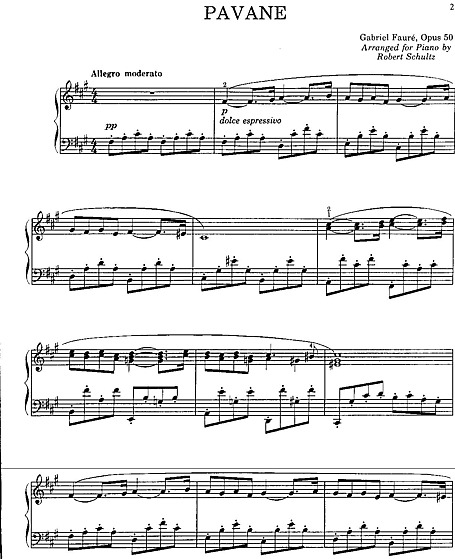Pavane
Piano Solo

- Compositor
- G U Fauré
- Opus
- Op. 50
- Tonalidad
- Fa sostingut menor
- Año de composición
- 1887
- Páginas
- 7
- Instruments
- Piano
- Dificultat
- Intermedi
- Llicència
- Domini públic
- Subido por
- Tony Wilkinson
- Mida del fitxer
- 2.35 MB
Escoltar

- Fauré plays Fauré Pavane, op 50
- Mestres de la Llista (La reproducció de Piano Player) Pavana, op. 50 Gabriel Fauré, piano youtube.com
Ressenyes
Acreca de Pavane
El texto superior está disponible bajo licencia de Creative Commons Atribution-SharAlike. El mismo usa material de un artículo de Wikipedia «Pavane (Fauré)».
Other sub titles
The Pavane in F-sharp minor, op. 50, is a composition for orchestra and optional chorus by the French composer Gabriel Fauré and dates from 1887. Obtaining its rhythm from the slow processional Spanish court dance of the same name, the Pavane ebbs and flows from a series of harmonic and melodic climaxes, conjuring a cool, somewhat haunting, Belle Époque elegance. The piece is scored for only modest orchestral forces consisting of strings and one pair each of flutes, oboes, clarinets, bassoons, and horns. A typical performance lasts around seven minutes., When Fauré began work on the Pavane, he envisaged a purely orchestral work to be played at a series of light summer concerts conducted by Jules Danbe. After Fauré opted to dedicate the work to his patron, Elisabeth, comtesse Greffulhe, he felt compelled to stage a grander affair and thus he added an invisible chorus to accompany the orchestra (with additional allowance for dancers). The choral lyrics were based on some inconsequential verses, à la Verlaine, on the romantic helplessness of man, which had been contributed by the Countess' cousin, Robert de Montesquiou-Fezensac., The orchestral version was first performed at a Concert Lamoureux under the baton of Charles Lamoureux on November 25, 1888. Three days later, the choral version was premiered at a concert of the Société Nationale de Musique. In 1891, the Countess finally helped Fauré produce the version with both dancers and chorus, in a "choreographic spectacle" designed to grace one of her garden parties in the Bois de Boulogne., From the outset, the Pavane has enjoyed immense popularity, whether with or without chorus. It entered the standard repertoire of the Ballets Russes in 1917, where it was alternatively billed as Las Mininas or Les Jardins d'Aranjuez. Fauré's example was imitated by his pupils, who went on to write pavanes of their own: Ravel's Pavane pour une infante défunte and Debussy's Passepied from his Suite bergamasque.,
Altres arranjaments
 HQ
HQ- Full Score
- Orquestra
Partitures gratuïtes en altres llocs
Compra ediciones impresas
Hemos seleccionado algunas ediciones impresas que creemos te puedan ser útiles.
- Pavane - Op. 50
- 8,00 €
- Piano Solo
- Edition Peters
- Pavane
- 12,07 €
- Voice, Flute, Piano
- Edition Peters
Más música de Gabriel Urbain Fauré

- Sicilienne
Piano solo - Piano
- Sicilienne
 ♪
♪- Dolly Suite
Piano a quatre mans
- Dolly Suite
 ♪
♪- Sicilienne
Cello or violin arrangement - Violoncel, Piano, Violí
- Sicilienne
 HQ
HQ- Sicilienne
Guitar Solo - Guitarra
- Sicilienne
 ♪
♪- Il est né, le divin Enfant
Veu, Piano, Orgue
- Il est né, le divin Enfant
A otros usuarios también le gustaron
 ♪
♪- Pavane pour une Infante défunte
Piano - Joseph-Maurice Ravel
- Pavane pour une Infante défunte
 ♪
♪- Suite Española No. 1
5. Asturias (Leyenda) - Isaac Albéniz i Pascual
- Piano
- Suite Española No. 1

- Romances sans paroles
No. 3 Andante moderato - Gabriel Urbain Fauré
- Piano
- Romances sans paroles
 ♪
♪- Peer Gynt Suite No. 1
4. In the Hall of the Mountain King (piano solo) - Edvard Hagerup Grieg
- Piano
- Peer Gynt Suite No. 1
 HQ
HQ- Amazing Grace
Bagpipes - Tradicional
- Amazing Grace










